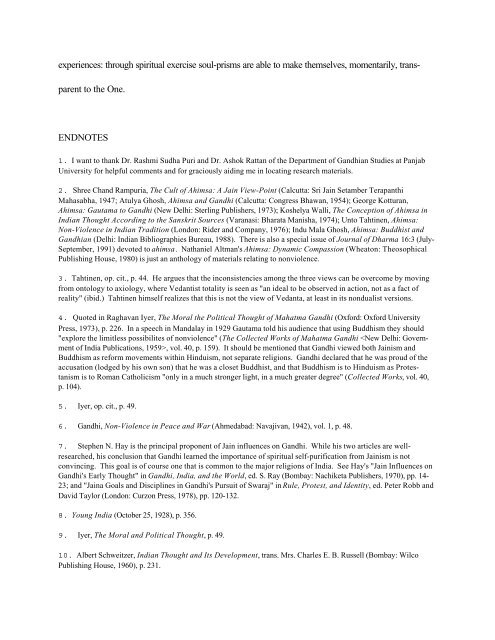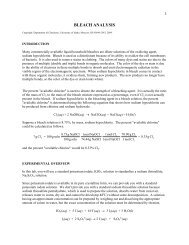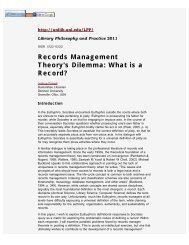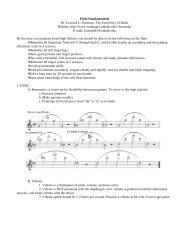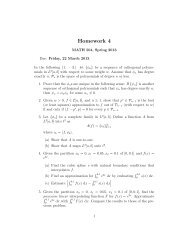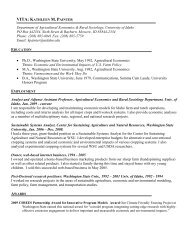Gandhi, Ahimsa, and the Self - University of Idaho
Gandhi, Ahimsa, and the Self - University of Idaho
Gandhi, Ahimsa, and the Self - University of Idaho
You also want an ePaper? Increase the reach of your titles
YUMPU automatically turns print PDFs into web optimized ePapers that Google loves.
experiences: through spiritual exercise soul-prisms are able to make <strong>the</strong>mselves, momentarily, trans-<br />
parent to <strong>the</strong> One.<br />
ENDNOTES<br />
1. I want to thank Dr. Rashmi Sudha Puri <strong>and</strong> Dr. Ashok Rattan <strong>of</strong> <strong>the</strong> Department <strong>of</strong> <strong>G<strong>and</strong>hi</strong>an Studies at Panjab<br />
<strong>University</strong> for helpful comments <strong>and</strong> for graciously aiding me in locating research materials.<br />
2. Shree Ch<strong>and</strong> Rampuria, The Cult <strong>of</strong> <strong>Ahimsa</strong>: A Jain View-Point (Calcutta: Sri Jain Setamber Terapanthi<br />
Mahasabha, 1947; Atulya Ghosh, <strong>Ahimsa</strong> <strong>and</strong> <strong>G<strong>and</strong>hi</strong> (Calcutta: Congress Bhawan, 1954); George Kotturan,<br />
<strong>Ahimsa</strong>: Gautama to <strong>G<strong>and</strong>hi</strong> (New Delhi: Sterling Publishers, 1973); Koshelya Walli, The Conception <strong>of</strong> <strong>Ahimsa</strong> in<br />
Indian Thought According to <strong>the</strong> Sanskrit Sources (Varanasi: Bharata Manisha, 1974); Unto Tahtinen, <strong>Ahimsa</strong>:<br />
Non-Violence in Indian Tradition (London: Rider <strong>and</strong> Company, 1976); Indu Mala Ghosh, <strong>Ahimsa</strong>: Buddhist <strong>and</strong><br />
<strong>G<strong>and</strong>hi</strong>an (Delhi: Indian Bibliographies Bureau, 1988). There is also a special issue <strong>of</strong> Journal <strong>of</strong> Dharma 16:3 (July-<br />
September, 1991) devoted to ahimsa. Nathaniel Altman's <strong>Ahimsa</strong>: Dynamic Compassion (Wheaton: Theosophical<br />
Publishing House, 1980) is just an anthology <strong>of</strong> materials relating to nonviolence.<br />
3. Tahtinen, op. cit., p. 44. He argues that <strong>the</strong> inconsistencies among <strong>the</strong> three views can be overcome by moving<br />
from ontology to axiology, where Vedantist totality is seen as "an ideal to be observed in action, not as a fact <strong>of</strong><br />
reality" (ibid.) Tahtinen himself realizes that this is not <strong>the</strong> view <strong>of</strong> Vedanta, at least in its nondualist versions.<br />
4. Quoted in Raghavan Iyer, The Moral <strong>the</strong> Political Thought <strong>of</strong> Mahatma <strong>G<strong>and</strong>hi</strong> (Oxford: Oxford <strong>University</strong><br />
Press, 1973), p. 226. In a speech in M<strong>and</strong>alay in 1929 Gautama told his audience that using Buddhism <strong>the</strong>y should<br />
"explore <strong>the</strong> limitless possibilites <strong>of</strong> nonviolence" (The Collected Works <strong>of</strong> Mahatma <strong>G<strong>and</strong>hi</strong> , vol. 40, p. 159). It should be mentioned that <strong>G<strong>and</strong>hi</strong> viewed both Jainism <strong>and</strong><br />
Buddhism as reform movements within Hinduism, not separate religions. <strong>G<strong>and</strong>hi</strong> declared that he was proud <strong>of</strong> <strong>the</strong><br />
accusation (lodged by his own son) that he was a closet Buddhist, <strong>and</strong> that Buddhism is to Hinduism as Protestanism<br />
is to Roman Catholicism "only in a much stronger light, in a much greater degree" (Collected Works, vol. 40,<br />
p. 104).<br />
5. Iyer, op. cit., p. 49.<br />
6. <strong>G<strong>and</strong>hi</strong>, Non-Violence in Peace <strong>and</strong> War (Ahmedabad: Navajivan, 1942), vol. 1, p. 48.<br />
7. Stephen N. Hay is <strong>the</strong> principal proponent <strong>of</strong> Jain influences on <strong>G<strong>and</strong>hi</strong>. While his two articles are wellresearched,<br />
his conclusion that <strong>G<strong>and</strong>hi</strong> learned <strong>the</strong> importance <strong>of</strong> spiritual self-purification from Jainism is not<br />
convincing. This goal is <strong>of</strong> course one that is common to <strong>the</strong> major religions <strong>of</strong> India. See Hay's "Jain Influences on<br />
<strong>G<strong>and</strong>hi</strong>'s Early Thought" in <strong>G<strong>and</strong>hi</strong>, India, <strong>and</strong> <strong>the</strong> World, ed. S. Ray (Bombay: Nachiketa Publishers, 1970), pp. 14-<br />
23; <strong>and</strong> "Jaina Goals <strong>and</strong> Disciplines in <strong>G<strong>and</strong>hi</strong>'s Pursuit <strong>of</strong> Swaraj" in Rule, Protest, <strong>and</strong> Identity, ed. Peter Robb <strong>and</strong><br />
David Taylor (London: Curzon Press, 1978), pp. 120-132.<br />
8. Young India (October 25, 1928), p. 356.<br />
9. Iyer, The Moral <strong>and</strong> Political Thought, p. 49.<br />
10. Albert Schweitzer, Indian Thought <strong>and</strong> Its Development, trans. Mrs. Charles E. B. Russell (Bombay: Wilco<br />
Publishing House, 1960), p. 231.


